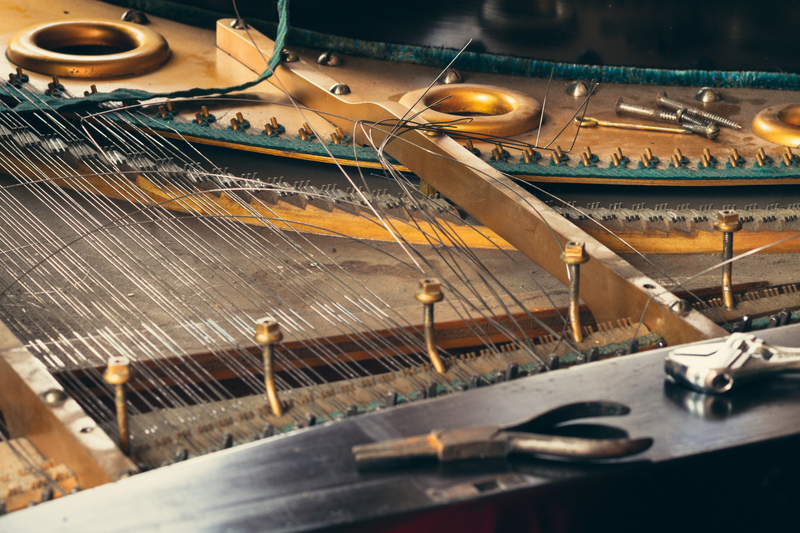How Heavy Is a Piano and What Makes Moving One So Challenging?
If you've ever admired the sheer presence of a piano in a living room or performance hall, you've likely also wondered: how heavy is a piano? And if you've ever needed to move one, you can attest to the _unique set of obstacles_ it presents. In this comprehensive guide, we'll delve into the weight of different pianos, explore why moving a piano is so complex, and provide expert insights on moving piano safely. Whether you're a curious pianist, planning a move, or simply intrigued by musical engineering, read on for an _in-depth_ look at the world of piano logistics.
Understanding Piano Weight: How Much Does a Piano Really Weigh?
Pianos come in various shapes and sizes, so their weights can differ vastly. Let's break down the average weights by piano type:
- Grand Pianos: Typically weigh anywhere from 500 to 1,300 pounds (227-590 kg). Concert grands can be even heavier, exceeding 1,400 pounds (635 kg).
- Upright Pianos: Most commonly range from 300 to 900 pounds (136-408 kg), depending on age, height, and materials.
- Baby Grand Pianos: On the lighter side for grands, these usually weigh between 500 and 600 pounds (227-272 kg).
- Spinet and Console Pianos: These most compact upright pianos generally weigh 200-400 pounds (91-181 kg).
- Digital Pianos: Except for some heavy hybrid models, these are considerably lighter, typically under 100 pounds (45 kg).
As you can see, piano weight is far from uniform. The main keyword variations related to "piano weight" include: how much does a piano weigh, weight of a grand piano, upright piano weight, and more. Each piano type presents its own unique moving challenges based on its size, build, and distribution of weight.
Key Factors Influencing a Piano's Weight
- Frame Material: Most modern pianos use an internal cast iron plate, which accounts for a significant portion of the weight (sometimes more than 50%).
- Wood Type: Premium hardwoods such as maple, spruce, and mahogany further contribute to the heaviness.
- Size and Model: Longer grands require a bigger, heavier frame and soundboard. Taller uprights are similarly heavier.
- Number of Keys and Pedals: A full-sized keyboard and extended pedal systems (like sostenuto) add extra weight.
- Age and Construction: Antique pianos are often much heavier due to solid materials and less efficient building techniques.
Beyond materials, internal mechanisms, and decorative elements (such as heavy casework or ornate legs) further sway the average piano weight.

Why Is Moving a Piano So Difficult?
Moving a piano is far more than a test of physical strength; it's a logistical challenge involving weight, size, fragility, and sensitive mechanics. Let's unpack the main reasons why moving pianos is such a specialized job.
1. Extreme Weight and Bulk
- Sheer Mass: With weights ranging from 300 to over 1,400 pounds, pianos are among the heaviest common household objects.
- Awkward Dimensions: Grands can be up to nine feet long and five feet wide; uprights may stand over four feet tall.
These bulk and mass make even the simplest move (like shifting the instrument to another wall) potentially hazardous.
2. Unbalanced Weight Distribution
A piano's weight isn't evenly spread. Much of it is concentrated in the plate, usually situated towards the back, creating a "top-heavy" or "back-heavy" center of gravity. This imbalance increases the risk of tipping or damage during a move.
3. Extreme Fragility
- Delicate Internal Components: The action (keys, hammers, dampers) is intricately balanced and easily thrown out of regulation by a jolt or bump.
- Sensitive Soundboard: The soundboard--a thin sheet of wood under enormous tension--can crack from shock or abrupt temperature changes.
- Exterior Damage Risk: High-gloss finishes mar easily, and even minor scratches can mean expensive repairs.
4. Physical and Environmental Challenges
- Stairs and Narrow Doorways: Few instruments are harder to manipulate around tight corners or multiple flights of stairs.
- Fragile Flooring: The weight of a piano can easily dent or crack wood floors and damage carpets if not carefully handled.
- Weather and Humidity: Exposure to rain, snow, or extreme heat can warp wood and damage tuning stability during transport.
5. Safety Concerns
Improper piano moving can result in serious injuries, including back strains, smashed fingers, and even severe accidents from tipping or dropping the instrument. Thus, professional piano movers are highly recommended for any large relocation.
Case Study: Popular Piano Types and Their Moving Challenges
Grand Piano
- Weight: 500-1,400 lbs (227-635 kg)
- Main Challenges:
- Requires removal of the legs and lyre (pedals)
- Must be set on a custom skid ("piano board")
- Extremely wide turn radius--tight hallways are problematic
- Needs more manpower (typically 3-6 movers)
Upright Piano
- Weight: 300-900 lbs (136-408 kg)
- Main Challenges:
- Heavily weighted near the back, increasing tip risk
- Hard to lift evenly due to tall, narrow design
- Antique models may have extremely thick frames and decorative legs
Spinet/Console Piano
- Weight: 200-400 lbs (91-181 kg)
- Main Challenges:
- Easier to maneuver, but still heavy compared to most furniture
- Compact size means less space for gripping safely
Each type of piano presents distinct logistical obstacles and demands special handling to prevent costly or irreparable damage.
Why Not Just Move a Piano Yourself?
Given the heavy piano weight, sensitive mechanics, and tricky move logistics, many people consider a DIY approach to save money. However, there are several compelling reasons why that's not advisable:
- Risk of Instrument Damage: Even a small bump can detune a piano, bend the frame, or break a leg, drastically reducing value and playability.
- Risk of Personal Injury: The immense weight and awkwardness make sudden slips or strains especially hazardous for non-professionals.
- Risk to Property: Walls, floors, and door frames often suffer during a poorly executed move.
- Lack of Specialized Equipment: Professional movers use reinforced dollies, ramps, straps, and custom padding--tools most households lack.
- Insurance Issues: Many professional movers carry specialized insurance for pianos; your typical rental truck policy will not cover losses.
It's always safer and often less expensive in the long run to hire experienced piano movers, rather than risk financial or physical loss from a DIY attempt.
How Professional Piano Movers Do It
So, what does professional piano moving actually entail? Here's a step-by-step look at how experts safely relocate these precious instruments:
- Assessment: Movers carefully measure the piano and all pathways (doors, staircases, elevators) for clearance.
- Disassembly (if needed): For grands, the legs and pedals are removed and packed separately. Uprights may have panels detached.
- Padding and Wrapping: The frame is swaddled in thick moving blankets, and fragile parts are bubble-wrapped.
- Lifting Properly: Using special piano dollies and lift straps, movers distribute the weight and avoid drops or scrapes.
- Navigation: Professionals maneuver through tight spaces without damaging the piano or home.
- Loading and Transport: The piano is securely strapped inside a truck with shock-absorbing equipment to prevent jostling.
- Unpacking and Setup: Upon arrival, movers reverse the process, reassembling the piano with precision.
This systematic approach minimizes risks and ensures your cherished instrument arrives unharmed and ready to play.

Tips for Preparing to Move Your Piano
If a move is in your future, follow these steps to safeguard your piano:
- Hire a Reputable Piano Mover: Get references, read reviews, and confirm insurance coverage.
- Measure: Double-check all doorways, hallways, elevators, and staircases for adequate clearance.
- Clear the Path: Remove rugs, furniture, and obstacles before movers arrive.
- Secure the Lid and Keys: Lock or tape the lid closed to prevent movement during transport.
- Check Humidity: Avoid moving during high humidity or precipitation; pianos are sensitive to moisture.
- Plan Tuning: After the move, schedule a piano tuning. Moves almost always leave the instrument slightly out of tune.
The Bottom Line: Respect the Mass and Marvels of Piano Moving
Piano weight is a testament to the incredible craftsmanship and musical potential packed into a single instrument. From the robust iron plate to the delicate hammers, the unique challenge of moving a piano is about much more than just brute force. It's a test of planning, expertise, and respect for both the piano's _artistic value_ and its formidable structure.
Whether you're moving an upright across the room or a grand to a new home, never underestimate the combination of piano heaviness and fragility. So next time you see or play one, take a moment to appreciate--not just the music--but the remarkable engineering and logistical wizardry that makes owning a piano possible.
FAQs About Piano Weight and Moving
- Q: What is the average weight of a piano?
A: The average upright piano weighs around 500 pounds (227 kg), while the average grand piano can weigh anywhere from 600 to 1,200 pounds (272-544 kg). - Q: Why do pianos weigh so much?
A: The primary reason is the cast iron plate inside every acoustic piano, which is essential for withstanding high-string tension (over 20 tons). Hardwood frames and dense soundboards also add substantial weight. - Q: Can four people move a piano?
A: While four strong adults might move certain upright or small grand pianos short distances, it's risky without professional equipment and experience. - Q: How much does a baby grand piano weigh?
A: Most baby grand pianos weigh between 500 and 600 pounds (227-272 kg). - Q: Does moving my piano affect its sound?
A: Moves usually jostle the piano enough to require a post-move tuning, but if moved carefully, long-term damage can be avoided.
In summary: How Heavy Is a Piano and What Makes Moving One So Challenging? The answer lies in the unique convergence of engineering, artistry, and logistics--providing a fascinating glimpse into the world of music and mechanics. Always treat your piano--and those who move it--with the utmost care and respect!



